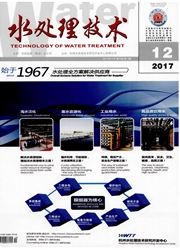

 中文摘要:
中文摘要:
为了评价二级串联自造粒生物流化床系统对各种污染物的降解性能,分别采用烧杯试验和连续试验对人工配水进行研究。结果表明,原水中COD为300 mg·L-1,烧杯混凝试验对配水中乙酸钠的去除能力有限,可混凝部分的质量浓度仅为3.8 mg·L-1,串联生物造粒流化床对溶解性乙酸钠的去除效果则相对较好,出水平均质量浓度达31.0 mg·L-1。对污染物在空间上分布的分析进一步反映了串联流化床系统内部各污染物的变化规律以及DO的变化对溶解性污染物的去除产生了重要的影响,即DO质量浓度能够在一级柱中从8 mg·L-1被迅速降低到2 mg·L-1,一级柱出水中大部分的溶解性乙酸钠被去除,平均COD为48.1 mg·L-1;二级柱中的DO质量浓度被消耗2.6 mg·L-1,而溶解性COD仅被去除了约20 mg·L-1。
 英文摘要:
英文摘要:
To estimate the degradation of contaminants in this system,it have been on research that are jar test and FPB with two stages' operation.The results show that,when COD of 300 mg·L-1 pumped into wastewater,it is limited to the removal of sodium acetate in wastewater for jar tests,and the coagulated part could be only 3.8 mg·L-1.Compared with jar tests,the removal of FPB with two stages' operation is much better that the average COD in the effluent is 31.0 mg·L-1.It could be further shown in the analysis of contaminants in the space distribution that the variation of contaminants in the system of FPB with two stages and the important influence of DO on the removal of soluble contaminants.As DO reduced from 8 mg·L-1 to 2 mg·L-1 in the primary column,most soluble sodium acetate could be removed and the average COD in the effluent could be 48.1 mg·L-1 in this part;and when 2.6 mg·L-1 DO have been used in the secondary column,soluble COD could be only removed for 20 mg·L-1.
 同期刊论文项目
同期刊论文项目
 同项目期刊论文
同项目期刊论文
 Characteristics of physicochemical adsorption of soluble matter by particles formed in a fluidized p
Characteristics of physicochemical adsorption of soluble matter by particles formed in a fluidized p 期刊信息
期刊信息
